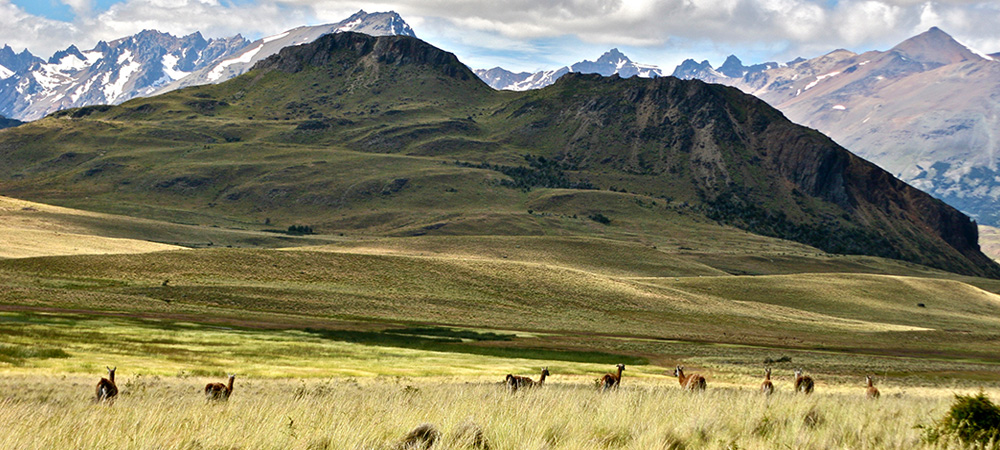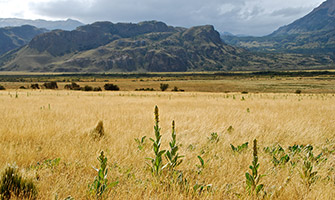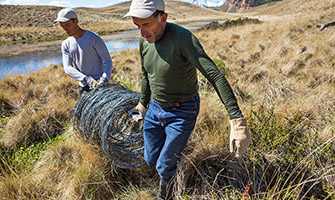Overview
Patagonia’s 400 million acres of temperate grasslands support a unique biological and cultural heritage, and provide many important ecosystem services such as clean air and water, forage for livestock, carbon sequestration, and habitat for wildlife. In 2004, the NGO Conservación Patagónica bought a 222,000-acre property that was formerly an overgrazed ranch in the Chacabuco Valley. Conservación Patagónica aimed restore the native grasslands and wildlife, and create a park to eventually donate to the Chilean government to create the Patagonia National Park. The main objective of the restoration project was to restore the Patagonia grassland ecosystem by rewilding and letting nature guide the restoration. The project has become one of the largest and most ambitious grassland restoration projects undertaken in the world.
Quick Facts
Project Location:
Chile Chico, Aysén Region, Chile, -46.7857319430108, -72.01788951726343
Geographic Region:
Latin America
Country or Territory:
Chile
Biome:
Grassland/Savanna
Ecosystem:
Grasslands & Savannas - Temperate, Montane Grasslands & Shrublands
Area being restored:
89030 hectares
Project Lead:
Conservación Patagónica
Organization Type:
NGO / Nonprofit Organization
Project Partners:
Tompkins Conservation
Chilean government
Conservation Land Trust
Fundación Pumalin
Fundación Yendegaia
Location
Project Stage:
Implementation
Start Date:
2004
End Date:
2020
Primary Causes of Degradation
Agriculture & LivestockDegradation Description
Most land in the area was privately owned and used for sheep ranching to produce wool and meat. Poorly managed ranching practices drove desertification in the area, leading to significant loss of native grasslands. Native animal species which rely on these grasslands, such as the guanaco population, were struggling to compete for food and space with an estimated 25,000 sheep and fencing blocking their movements.
Defining the Reference Ecosystem
The reference ecosystem is based on diverse sources of information (e.g. multiple extant reference sites, field indicators, historical records, predictive data).Reference Ecosystem Description
The Patagonia Park grasslands lie in the Chacabuco Valley. The Chacabuco Valley is one of the few east-west valleys in the region, creating an ecologically rich transition zone between ecosystems. Grasslands ecosystems have less wildlife diversity compared to, say, tropical rainforests, they typically have more abundant wildlife. Species such as guanacos—the region’s iconic large mammal— as well culpeo foxes, armadillos, Andean condors, pumas, and rhea’s once dominated the landscape. Fires do not occur naturally in the Patagonia landscape and can be extremely harmful.
Project Goals
- Provide positive outcomes for people, wildlife and grasslands including protection and restoration of grasslands and their unique and fragile environments, and sustain the economic vitality of surrounding ranches which adopt sustainable practices.
- Maintain viable populations of key native wildlife species including puma, red fox, rhea, and guanaco.
- Reintroduce wildlife to the landscape through a rewilding program, especially focused on reintroducing top predators.
- Restore grassland ecosystem functionality.
Monitoring
The project does not have a monitoring plan.
Stakeholders
Conservacion Patagonica organizes volunteer programs to assist in the restoration process by removing invasive plants and spreading native seeds throughout the valley. Collaboration among Conservacion Patagonica, the Conservation Land Trust, Fundación Pumalin, Fundación Yendegaia and the Foundation for Deep Ecology has promoted the adoption of advanced sustainable agriculture, the development of local communities and a culture of activism that inspires local people and tourists to respect and defend wildlife. Working with local communities, the park has implemented an outdoor education program that brings young people to the park for natural science and physical education activities.
How this project eliminated existing threats to the ecosystem:
The park land is now protected from ranching practices, and local ranchers and communities have been engaged in finding sustainable ranching and agricultural practices. Park volunteer groups have been removing and controlling nonnative plants that were introduced through livestock grazing and human development such as musk thistle, poison hemlock, spear thistle, and common mullein.
How this project reinstated appropriate physical conditions (e.g. hydrology, substrate)",:
The sheep were sold and over 400 miles of fencing was removed from the areas of land bought by the NGO Conservación Patagónica. Researchers have gathered soil samples to develop management plans for different areas and established research plots to test the effectiveness of reseeding and erosion control practices.
How this project achieved a desirable species composition:
Native species were bred and reintroduced as part of a comprehensive rewilding program.Through a captive breeding project, park biologists are helping grow the population of Darwin’s rheas, the native ostriches. Native plants are being strategically reseeded. Volunteer conservationists collect seeds from native grasses, especially the coiron species, for use in reseeding heavily damaged areas.
Ecological Outcomes Achieved
Eliminate existing threats to the ecosystem:
Native plant species have been slowly recovering from the effects of desertification and invasive species.
Reinstate appropriate physical conditions",:
The Chacabuco Valley has made impressive and visible strides towards erosion control and recovery, but complete restoration will take decades.
Achieve a desirable species composition:
Native guanaco herds have flourished from an unsustainable population of several hundred to an estimated 3,000. Other native animal species have been returning to the landscape, but quantification is still undergoing as the project is not completed.
Recover ecosystem functionality:
The Chacabuco Valley’s grassland ecosystem is experiencing an amazing and faster than expected recovery.
Socio-Economic & Community Outcomes Achieved
Economic vitality and local livelihoods:
Ranching is important for local livelihoods around Patagonia Park. Conservacion Patagonica, the Conservation Land Trust, Fundación Pumalin, Fundación Yendegaia and the Foundation for Deep Ecology have engaged the local community and specifically local ranchers to develop and adopt sustainable agricultural practices, and good practices in grassland management and stewardship.
Key Lessons Learned
- Removing the livestock was a crucial step toward preventing the collapse of the Patagonian ecosystem.
- Rewilding is essential to avoid extinction, and is important to not only preserve the landscape and wildlife, but also to clean water, forests, and create functional ecosystems. Top predators in the grassland ecosystem are critical because if the population of guanacos explodes this affects the grass and the whole ecosystem.
Long-Term Management
Conservacion Patagonica will continue to oversee implementation and post-implementation management. The goal is for the Patagonia Park land to be donated to the Chilean government within the decade to create the Patagonia National Park, at which time the government will oversee the maintenance of the restored ecosystem.
Sources and Amounts of Funding
Kris Tompkins and Doug Tompkins, have contributed $170m to the rewilding, along with an estimated $45m from philanthropists around the globe.
Other Resources
http://www.tompkinsconservation.org/home.htm
https://initiative20x20.org/restoration-projects/ecological-restoration-chacabuco-valley
https://cbey.yale.edu/sites/default/files/Patagonia%20Park.pdf
Primary Contact
Name:
Kris Tompkins
Affiliation:
Tompkins Conservation




